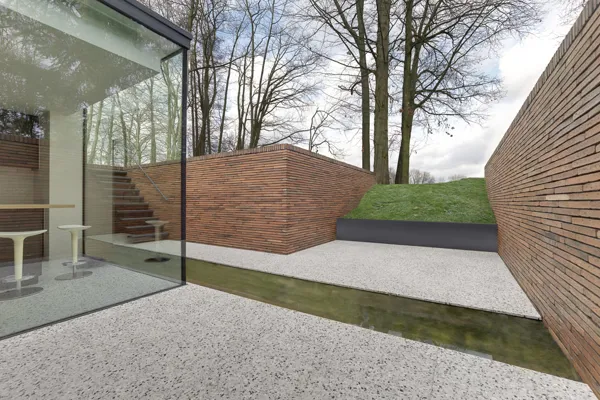Facing bricksInfinitum 3003
Technische informatie
- Kleur omschrijving
- The colour is red through and through and highly nuanced ranging from red, red-brown to purple-blue.
- Afmeting (L x B x H)
- ca. 500x100x38 mm (LxBxH)
- Aantal / m² met een traditionele voeg
- 40
- Aantal / m² met een dunne voeg
- 45
Infinitum 3003
Ruby red long-format brick
This extra-long facing brick with subtle shading is produced using the Wasserstrich method. It also carries our Hand-Made label which guarantees a strong, natural nuance. This red unsanded variant from our infinitum series is ideal for accentuating horizontal linear designs in decorative brickwork.
reportage Infinitum 3003

Brick-clad office building with Infinitum 3003, the tone has been set!
The link between traditional and innovative architecture
When the project manager and the architect are one and the same person, the outcome is always awaited with keen anticipation. It invariably leads to unique realisations that exhibit great attention to detail.
Lees verder
Referenties
Verwerkingstips
Preparation of the construction site
Quality brickwork starts with the proper storage of the materials. Provide a firm level base so that bricks are not in contact with rain and/or dirt.
As clay is a natural material, successive production runs of the same kind of bricks may present colour variations and size tolerances.
The following precautions will help minimizing this:
- Always order the full amount of bricks required for a specific site. In this way, the entire order can be made during one production run.
- Try to have the full order supplied at one time. If this creates several deliveries, always mix a number of packs from the previous delivery with a number of packs from the new delivery. This procedure is especially recommended in case of re-order or for an additional order.
- Take bricks diagonally across the pack.
- Draw and use bricks from at least five different packs.
- For setting out, use bricks from the delivery made to the site in question. Do not exclusively use the theoretical dimensions of the brick, or samples previously supplied, or different production run from that intended for the site.
- As soon as the bricks arrive on site, check delivery tickets and certificates against the specification and order. Also check that there are no visible inconsistencies with the order.
- Do not lay bricks in freezing weather or protect the ‘fresh’ masonry with insulating mats in order to avoid frost damage to the mortar.
- In the case of prolonged dry hot weather, lightly dampen the newly laid brickwork to stop the mortar drying and curing too quickly.
- Do not lay bricks in precipitation in order to prevent mortar from running on the wall.
Avoid Efflorescence
Brickwork is sometimes marred by white bloom. This efflorescence is usually caused because bricklaying is done under unfavourable weather conditions. The necessary protective measures are often not implemented due to a tight schedule and fast building pace. In very wet conditions, water in soluble substances can result in efflorescence on the surface. In spring as well as autumn, after a wet period (when the brickwork has dried again), soluble substances can rise to the surface as a result of moisture transport. After evaporation of the water, a white bloom is left behind. (Source: Efflorescence on brickwork – Heidelberg Cement Group)
Efflorescence on brickwork is always likely to occur. There is no brick - or combination of a certain brick with a specific mortar - that is absolutely efflorescence-free. By taking a few simple precautions, the risk of efflorescence can be reduced.
- During and after laying, protect the newly built brickwork for a height of at least 60 cm - but ensure there is airspace between the brick face and the waterproof covering.
- Provisionally install rainwater down pipes to avoid saturation of the newly laid brickwork
- Never lay bricks in driving rain conditions




















